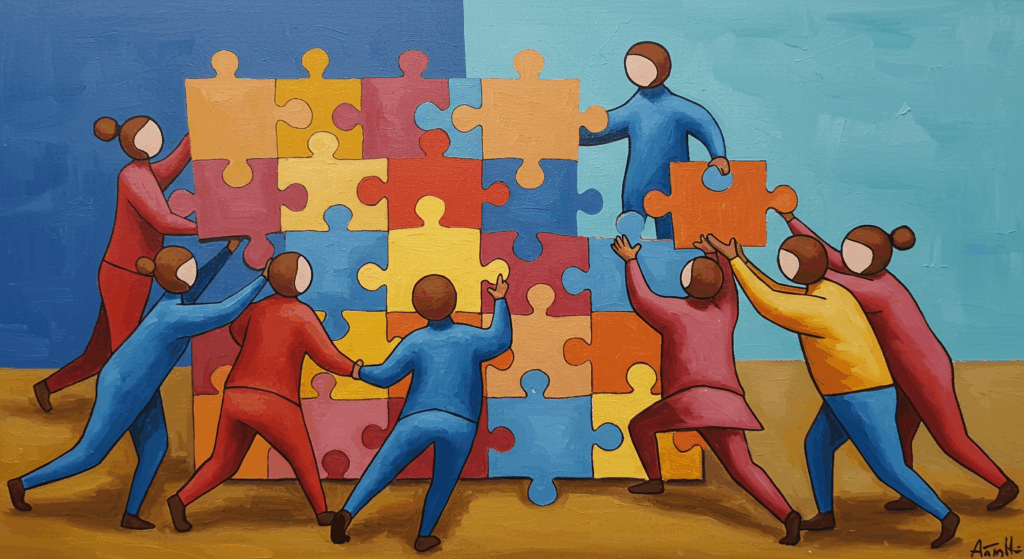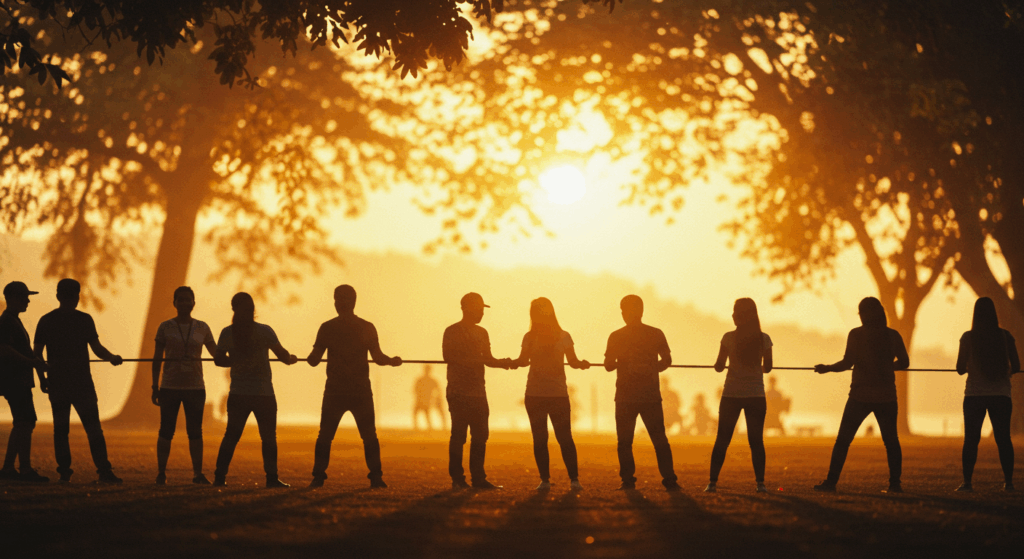Let’s be honest: the phrase “corporate team activities” can make even the most extroverted among us suddenly fascinated by a very urgent email. You’ve probably survived a few awkward icebreakers, waved half-heartedly on Zoom, and built a spaghetti tower that collapsed faster than your will to small-talk. Same. But also—hear me out—when team building is done with intention (and a sense of humor), it can actually be good. Like, fun good. “I’d do that again” good.
This guide is your no-fluff, friendly playbook to planning team building, corporate events, and group exercises that feel natural, inclusive, and genuinely helpful. No trust falls. No “forced fun.” Mostly vibes, clarity, and a bit of structure so your tem leaves feeling less like strangers and more like, well, a team.
Why Corporate Team Activities Matter (and Not Just for HR)
If you’ve ever tried to launch a project with strangers, you know the pain: misread Slacks, weird silences, “oh I thought you owned that” energy. Well-planned corporate events and small, weekly group exercises fix a surprising amount of that mess by creating:
- Faster collaboration: People who’ve built something small together can build bigger things faster. It’s like friendship speedrun.
- Better comms: After structured activities that teach listening or clarity, “Can I clarify?” becomes normal, not awkward.
- Psych safety: It’s easier to speak up in a meeting when you’ve already been wrong (and laughed about it) in a low-stakes exercise.
- Sticky culture: Teams that share stories and inside jokes tend to stick around longer. Not the cringe kind—real memories.
No, one offsite won’t fix a toxic org. But a drumbeat of intentional team building structures can absolutely boost trust, momentum, and results. Like gym sessions for your culture. (Except you don’t need special shoes.)
Principles That Make Team Building Not Suck
Before we jump into the menu of activities, a few guidelines so nobody rolls their eyes:
- Tie it to a real goal. Pick one: trust, clarity, creativity, problem solving, conflict skills, recognition, cross-team bonding. If your activity doesn’t ladder to a goal, it’s just… noise.
- Keep it safe, not soft. Safety = respectful, opt-in moments, no humiliation, no surprise spotlighting. You can still be ambitious and real.
- Choose the right energy level. Monday 9 a.m. might be a chill “coffee roulette” day; Thursday afternoon might handle a faster-paced challenge.
- Timebox and debrief. Short bursts (15–45 minutes), then a fast retro: “What worked, what didn’t, what we’ll keep.”
- Design for inclusion. Remote-friendly alternates, accessibility considerations (mobility, neurodiversity, sensory), and cultural awareness. Make it easy to participate without disclosing personal stuff.
- Don’t force personal vulnerability. People aren’t therapy content. You can build closeness with playful challenges and shared wins.
Quick Wins: Low-Lift Group Exercises for Any Team
These are 10–30 minute activities you can run during weekly standups or monthly syncs. Minimal prep, high ROI, no cringe.
Warm Ups That Don’t Feel Like Icebreakers
- Two Truths & a Stretch (Remix). Each person shares two true work wins and one stretch goal for the quarter. The team guesses the “stretch.” It’s a sneaky way to surface aspirations without pressure.
- Emoji Mood Check. Everyone picks 2 emojis to describe their week and explains in one sentence. This normalizes emotional context without oversharing. 😅☕
- Desk Safari (Remote). 30 seconds: find an object that says something about your day. Show it, 1 sentence only. Fast and funny.
Collaboration Boosters
- Silent Build. Give small groups a diagram (or a Lego-like task) and ask them to replicate it without speaking—only written notes. Debrief: how did we communicate? What did we assume?
- The Constraints Game. “Design a welcome experience for new hires in 15 minutes with a $50 budget and 2 hours total time.” Present rapid prototypes. Constraints = creativity.
Communication & Clarity
- The 60-Second Brief. One person explains a tricky topic in 60 seconds; the group restates the message in their own words. It’s a masterclass in distilling ideas. (Gold for PMs.)
- Story Relay. Start a story relevant to your product or customers; each person adds one sentence. It trains attentive listening and “yes-and” collaboration.
Feedback (Without the Weirdness)
- Kudos Lightning Round. One minute per person: name one micro-win you noticed from a teammate this week. Keep it specific. Tiny praise, big morale.
- Mini-Retro: Rose, Thorn, Bud. Rose = win, Thorn = challenge, Bud = oportunity. Quick cycles build a habit of learning without blame.
The “Menu” of Team Building Activities by Goal
Pick your goal, then try one of these. These can be run as monthly sessions (45–90 minutes) or part of larger corporate events.
1. Goal: Build Trust (Without Trauma-Bonding)
- Common Thread. In small groups, find three non-obvious things you all share (not family, not alma mater). Forces a deeper conversation than “we all like coffee.”
- Values in Action. Each person picks a core value (e.g., curiosity), then shares a recent time they lived it at work. Prompts pride + alignment.
2. Goal: Sharpen Problem-Solving
- Mystery Box Challenge. Teams get a bag of random items and a customer scenario. Build a prototype and 30-second pitch. Absurdity is allowed. Creativity thrives in constraints.
- Backwards Planning. Start from a desired outcome (“100k active users”) and plan backward in 5 steps. It’s crisp, logical, and great for cross-functional groups.
3. Goal: Improve Communication
- Teach Me Like I’m New. Each person explains their role’s “top 3 responsibilities” to a non-expert in 2 minutes. Then the listener summarizes. It kills silos fast.
- Signal vs Noise. Give a brief full of fluff and ask teams to edit it to 3 bullet points. Debrief what made the cut.
4. Goal: Kickstart Creativity
- Brainwriting (Not Brainstorming). Everyone silently writes 5 ideas in 5 minutes, passes the sheet, builds on the next person’s ideas. Repeat 3 rounds. Present favorites.
- Odd Pairing. Combine your product with a random thing (“our app + a farmer’s market”). Generate 10 wacky features. Sometimes a gem emerges.
5. Goal: Boost Recognition & Belonging
- Win Wall. A shared doc or wall where people stick recent wins (team and personal). Add “what I learned” to make it educational.
- Peer Shoutouts. Open a 3-minute timer: everyone DMs the facilitator a quick shoutout; facilitator reads them anonymously. Warm fuzzies + zero pressure.
Corporate Events With Purpose (Offsites, Onsites, and Hybrids)
Big moments = big leverage. If you’re going to pull the team together for a day or two, design it like a great playlist: a strong opener, hits in the middle, and a genuinely good closer.
Offsite That People Remember
- Day 1: Connection & Direction
- Welcome + “State of the Team” (30 min): wins, truth, and what’s next. Keep it candid.
- Group Exercises (60 min): Silent Build or Mystery Box to warm up collaboration.
- Working Sessions (2 × 60 min): Cross-functional deep dives tied to real business goals.
- Reflection Walks (30 min): Pair up, walk, discuss prompts. Movement helps thinking.
- Day 2: Strategy & Skills
- Lightning Talks (45 min): 5× speakers, 7 minutes each, from across functions.
- Team Building (60 min): Brainwriting sprint on a real product or ops challenge.
- Commitments & Checkouts (30 min): Each person names one action for the next 30 days.
Hybrid-Friendly Event (Works Remote + Onsite)
- Asynchronous pre-work: 2–3 short Looms or docs to prime brains.
- Core 3-hour live block: Energizer → co-creation session → show-and-tell → mini-retro.
- Virtual social: Coffee roulette or game hour (trivia, word puzzles, low-key, screen-share friendly).
- Accessibility note: Auto-caption everything, provide dial-in options, avoid “camera-on or else.” Autonomy = trust.
Retreats Without The Cringe
- Give it a focal point. Learning theme, customer immersion, or product jam. “Just hanging out” gets boring quickly.
- Unstructured time is a feature. Leave real breaks. Ngl, being over-scheduled is exhaustimg and kills spontaneous, real conversations.
- Do one memorable thing. A cooking class, a local volunteering project, a low-key hike—something that becomes the story.
Remote-First? Try These Digital-Forward Activities
Remote teams can do all the same things with small tweaks, plus some benefits: global perspectives and flexible schedules.
- Coffee Roulette Bot (or spreadsheet). Pair random teammates for 15-minute chats weekly. Provide icebreaker prompts to keep it smooth.
- Virtual Escape Rooms / Puzzle Hunts. Choose ones with cooperative mechanics. Debrief: who took which roles, how did comms flow?
- Async Appreciation Thread. Weekly Slack thread: “One thing I appreciated this week.” It’s shockingly effective and takes ~30 seconds.
- Map the World. Have folks pin their city on a shared board, then share a local food they love. You’ll get recipes and empathy for time zones.
- Show the Work. Monthly 30-minute “demo day”—3× 8-minute demos of anything: code, ops, design, recruiting data. Keep it fast and celebratory.
Planning Corporate Team Activities Step-by-Step
If you’re the person voluntold to plan, here’s a sanity-saving blueprint.
1) Start With One Clear Outcome
Examples:
- “Reduce handoff confusion between Product and Customer Success.”
- “Help new hires build relationships beyond their immediate pod.”
- “Spark three shippable ideas for Q4 marketing.”
2) Pick the Right Format
- 10–15 minutes: warmups, check-ins, micro retros.
- 30–60 minutes: a single group exercise with debrief.
- Half-day: mix of strategy + creative + social.
- Full offsite: two days max unless there’s deep training.
3) Define Roles
- Host: sets tone, keeps time, frames the “why.”
- Facilitator(s): guide exercises and protect the process (not the loudest voices).
- Scribe: captures decisions + next steps.
- Producer (remote): handles breakout rooms, recordings, chat flow.
4) Build a Simple Agenda (Example: 90 Minutes)
- 0:00–0:05 — Welcome, outcome, norms (“assume good intent, share airtime”).
- 0:05–0:12 — Energizer (Emoji Mood Check).
- 0:12–0:45 — Main group exercise (Brainwriting).
- 0:45–1:05 — Share & prioritize ideas (dot vote).
- 1:05–1:20 — Action planning (owner + next step + date).
- 1:20–1:30 — Mini-retro (Rose/Thorn/Bud) + thank-yous.
5) Make Inclusion Real (Not a Slogan)
- Offer alternatives to physical tasks.
- Use content warnings if needed; never surprise people with personal prompts.
- Avoid inside jokes as “activities.” If only half the team gets it, it’s exclusionary.
- For food: always provide veggie/halal/vegan and label allergens—bare minimum.
6) Close the Loop
- Share notes in 24 hours.
- Follow up on commitments at the next team meeting.
- Send 2-question pulse check: “What was valuable?” “What should we change?”
Budget-Friendly vs. Fancy: What to Choose
You don’t need a castle retreat (unless you have one, in which case, hi 👋). Great team building scales.
Free / Nearly Free
- Brainwriting sessions
- Cross-functional “teach me” talks
- Coffee roulette
- Volunteer coordination with local nonprofits
- Book/article club discussion (short, accessible reads)
Mid-Range
- Virtual escape room passes
- DIY cooking class with reimbursed groceries
- Facilitation coach for a half-day strategy workshop
- Swag kits mailed for hybrid events (snacks + sticky notes + pens = morale rocket)
Premium
- Offsite venue + travel
- External facilitator for conflict/comms training
- Hands-on customer immersion (store visits, ride-alongs)
- Production support (A/V, design, event ops)
Pro tip: spend on meaning, not theatrics. People remember feeling seen and accomplishing something together way more than a DJ.
Sample Activity Recipes You Can Run Tomorrow
Steal these. Customize. Don’t over-explain—just go.
1) Brainwriting Sprint (45 Minutes)
Goal: Generate many ideas without loud-voice dominance.
How:
- Frame the problem in one sentence.
- 5 minutes: each person silently writes 5 ideas.
- Pass ideas (or rotate digital doc), build on them for 5 minutes.
- Repeat once more.
- Share top 2 per person. Dot vote. Pick 3 to prototype.
Debrief prompts: What patterns did we see? Which constraints helped?
2) Silent Build (30–40 Minutes)
Goal: Improve nonverbal and written comms.
How: Provide a build reference; materials must be requested via notes only. No talking.
Debrief: Which channels worked? What instructions failed? Map to your everyday handoffs.
3) Feedback Speed Dating (30 Minutes)
Goal: Normalize fast, kind feedback.
How: 5× 5-minute rounds in pairs. Prompt: “One thing you did recently that helped me; one suggestion to help us work smoother.”
Rules: Specific, kind, no fixes unless asked.
Debrief: What made feedback land well?
4) Customer Story Swap (40 Minutes)
Goal: Align around the customer.
How: Each person brings one customer story—good, bad, or weird. In groups of 3, share, then extract one insight + one action.
Debrief: Which themes repeat? What will we change?
Measuring ROI Without Killing the Vibes
Yes, feelings matter. Also yes, your COO wants numbers. Track a handful of signals:
- Leading indicators: Post-event survey (1–5): clarity, trust, energy. Pulse it again in 30 days.
- Operational signals: Cycle time on cross-team work; fewer “who owns this?” posts; smoother handoffs.
- People signals: Opt-in attendance rates, 1:1 feedback mentions, retention on teams that participate.
Pro move: tie team building to an actual business outcome. Example: after monthly group exercises focused on clarity, your bug resolution time drops 18%. That’s a headline you can bring to leadership.
Common Mistakes (So You Can Dodge Them)
- Forcing vulnerability. Skip prompts that pry into personal trauma. Keep it work-relevant and opt-in.
- Over-scheduling. When people don’t get real breaks, the social battery hits 2% and everything feels forced.
- Ignoring time zones. If you’ve got folks around the world, rotate times or run two sessions and stitch outputs.
- No debrief. Fun without reflection is fine for Friday night, not for corporate events meant to improve teamwork.
- One-and-done. The magic is consistency. Light, regular team bilding beats a yearly mega-offsite every time.
Make It a Rhythm: An Annual Team Building Cadence
Here’s a simple, sustainable schedule that balances corporate events with micro-moments:
- Weekly (10–15 min): Mood check + mini-win share, rotating group exercises (brainwriting, kudos).
- Monthly (60–90 min): Focused team building workshop aligned to a real problem (handoffs, priorities, customer insights).
- Quarterly (Half-Day): Strategy + skill-building + demo day + social.
- Biannually (1–2 Days): Offsite or hybrid summit with learning, co-creation, and memorable shared experiences.
This cadence is light enough to not break calendars but heavy enough to shape culture.
Real Talk: How to Get Leadership Buy-In
- Start small and show receipts. Pilot with one team, gather outcome stories + pulse data.
- Tie it to KPIs. “We’re targeting a 20% faster handoff by Q2. Monthly team building will focus on clarity and decision rights.”
- Invite leaders to listen, not just speak. Give them a role in one exercise (timekeeper, scribe, interviewer).
- Share a one-pager post-event. Outcome, top decisions, next actions, owner + date. Leaders love crisp recaps.
Templates You Can Copy-Paste
One-Slide “Why This Matters”
- Goal: Improve cross-team clarity
- What we’ll do: 45-min brainwriting + action plan
- Expected outcome: 3 shippable ideas + owners
- How we’ll know: Post-survey + cycle-time check in 30 days
Debrief Questions (Keep It Consistent)
- What surprised you?
- What felt energizing vs. draining?
- What will we try differently next time?
- One shoutout to a teammate from today?
Social Prompts That Aren’t Cringe
- “What’s an app you’d pay double for?”
- “What tiny tool saved you 10 minutes this week?”
- “What’s a hill you’ll die on (light edition)?” (e.g., tabs vs. spaces, pineapple on pizza)
Advanced Mode: Leveling Up Your Corporate Events
When the basics are smooth, add one of these:
- Customer Panel. Invite 2–3 real customers to a 30-minute Q&A. Prepare questions and listen. Team building via external reality.
- Live Usability Jam. Watch someone use your product for the first time. Everyone takes notes, then 20-minute “fix it” sprint.
- Decision Jam. Frame a tough call. Use a structured decision method (pros/cons, impact/effort matrix). Commit and assign owners.
- Learning Passport. Each teammate picks a mini-skill (Figma basics, SQL 101, storytelling). Present a 3-minute demo at the next event.
Personal Note (Because We’re Humans Here)
I used to roll my eyes at “team bonding,” ngl. But the truth is, we all want to feel like we’re rowing in the same direction with people we respect—and occasionally laugh with. When team building nails that sweet spot between purpose and play, things shift. Meetings get crisper. Slack gets kinder. Deadlines feel like challenges, not punishments. You start to trust that the person on the other end of the doc is trying—like you are.
And yeah, sometimes an activity will flop. That’s fine. Call it out, tweak it, try again. Culture is built in loops, not once-a-year extravaganzas.
Your Next Step (Pick One, Seriously)
- Drop 15 minutes on the calendar for a group exercise next week (Brainwriting or Silent Build).
- Plan a tiny corporate event next month—90 minutes, one goal, one win.
- Start a weekly kudos thread today. Like, right now.
You don’t need a big budget or a perfect plan. You just need a clear purpose and a little courage to try. Start small, keep it human, and iterate. Your future self—and your team—will thank you. Go make something awesome together.









